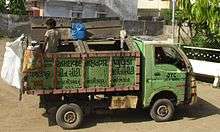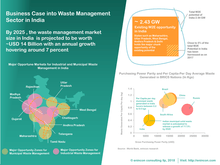Waste management in India
The solid waste policy in India specifies the duties and responsibilities for hygienic waste management for cities and citizens of India. This policy was framed in September 2000, based on the March 1999 Report[1] of the Committee for Solid Waste Management in Class 1 cities of India to the Supreme Court, which urged statutory bodies to comply with the report’s suggestions and recommendations. These also serve as a guide on how to comply with the Municipal Solid Waste (MSW) rules. Today, India is one of the places in the world where most garbage is disposed. Indian landfills contain dangerous materials, including plastics and chemicals.[2] Both the report and the rules, summarised below, are based on the principle that the best way to keep streets clean is not to dirty them in the first place. So a city with street bins will ultimately become clean and stay clean.[2] They advocate daily doorstep collection of "wet" (food) wastes for composting, which is the best option for India. The decrease in cost of old bottles has created waste disposal problem in Kerala, India [3] This is not only because composting is a cost-effective process practiced since old times, but also because India’s soils need organic manures to prevent loss of fertility through unbalanced use of chemical fertilizers.[4]
ASSOCHAM Report

According to the Associated Chambers of Commerce and Industry (ASSOCHAM), "India is generating 130 million tonnes of e-waste as of 2018, a dramatic increase from the 93.5 million tonnes of 2016. By 2020, India is expected to generate 260 million tonnes of e-waste".[5][6]
Laws
As per Rule 4 of the Municipal Solid Wastes (Management and Handling) Rules, 2000, "every municipal authority is responsible for infrastructure for segregation and processing of municipal solid waste (MSW), commonly known as garbage".[7]
Waste Management Market in India

By 2025 , the waste management market size in India is projected to be worth ~USD 14 Billion with an annual growth hovering around 7 percent. [8]
Considering the current urban trends, it is not at all surprising to mention that the MSW quantum in India can see an increase of double the existing volumes by ten years down the line. Infact, it is projected to hover around 80-85 MTs by 2030, offering a business case of approximately USD 20 Billion.
Growing economy, soaring urban population, rising living standards and increasing consumption levels – is what trending in the emerging economies across the globe . With India flourishing on the same grounds, an increase in the purchasing power parity has led to more affordability, accessibility to resource use and a rapid surge in the waste volumes as well.
City-based initiatives
Before a national consolidated effort for systematic and total waste management came into common consciousness, many cities and towns in India had already launched individual efforts directed at municipal waste collection of segregated waste, either based on citizen activism and/or municipal efforts to set up sustainable systems. Some examples are Swach [9]based in Pune (formed in 1993), and Solid Waste Management Round Table, Bangalore (formed in 2009). [10] Bangalore's Bruhat Bangalore Mahanagara Palike was directed by the High Court of Karnataka to implement mandatory segregation of municipal waste at the household level before collection[11] - a first for the country. This was a direct effort of citizen-based activism at a local level, and the litigation was led by notable activists such as Almitra Patel and Nalini Shekar. Following this High Court ruling, other cities in India have also followed suit to make segregation of municipal waste mandatory at the generator level, Mumbai [12] being one of the notable examples.
IT initiatives
The Government of India launched a web application in 2016 to track the status of various kinds of wastes generated in India.[13]
See also
References
- ↑ "Maharashtra Pollution Control Board". mpcb.gov.in. Retrieved 2018-01-25.
- 1 2 http://www.almitrapatel.com/supreme.htm
- ↑ Waste Management Problems in Kerala
- ↑ http://www.almitrapatel.com/specialwastes.htm
- ↑ "India will generate 130 million tonnes of e-waste by 2018: Assocham", The Times of India, Bengaluru, 3 June 2016
- ↑ "India`s e-waste growing at 30% per annum: ASSOCHAM-cKinetics study", ASSOCHAM, Bengaluru, 3 June 2016
- ↑ "Solving India's waste disposal problem", The Financial Express, 3 June 2016
- ↑ "Waste to Energy and Waste Management Market in India 2018". enincon.com. Retrieved 2018-01-31.
- ↑ https://swachcoop.com
- ↑ http://swmrt.com/
- ↑ https://www.thehindu.com/news/national/karnataka/high-court-notice-to-government-on-segregation-of-waste-at-source/article3708796.ece
- ↑ https://timesofindia.indiatimes.com/city/mumbai/Soon-segregation-of-dry-and-wet-waste-will-be-compulsory-all-housing-societies/articleshow/55820318.cms
- ↑ "Government launches web-based integrated waste management system", The Times of India, 25 May 2016